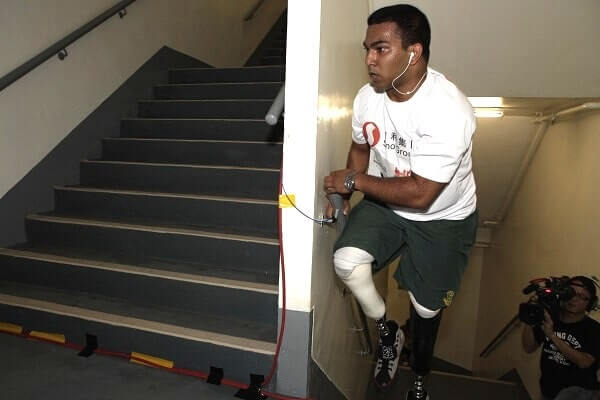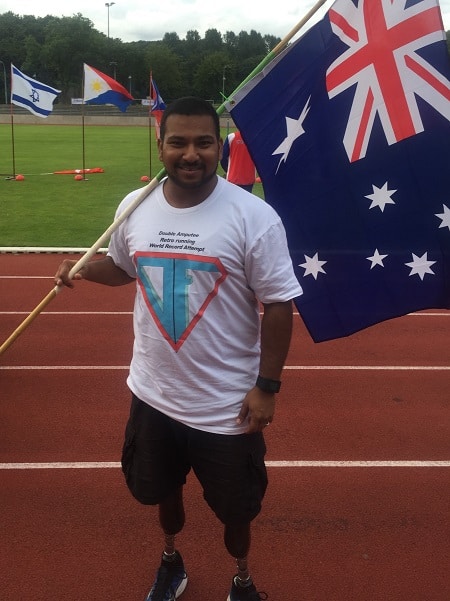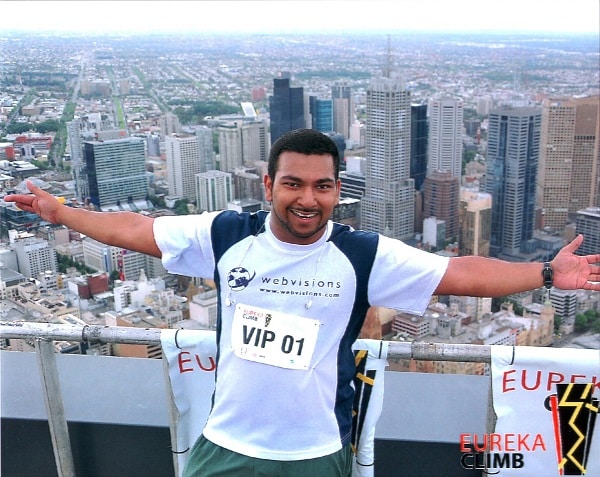In 2008, 22-year-old Dwayne Fernandes was working as a consultancy accountant in the MLC Centre in Sydney’s CBD. His work view encompassed the city skyline including a particular towering landmark, Centrepoint Tower, or Sydney Tower Eye as it’s now known. It was then that a colleague approached Dwayne with an invitation to join them in running up the tower.
“None of these people knew I had false legs. I wore long pants and formal shoes, so no one could tell that I am a double leg amputee,” Dwayne told Indian Link. “I phoned up the organizing committee of the tower climbing event and asked them, ‘Hey, have you ever had anybody with false legs run up Centrepoint tower?’. The person said they would make some inquiries and call back. ‘No. We’ve never had anybody with false legs run up the tower,’ they said. ‘Please come, you’d be setting a world first!’”
“Who am I to say no to a world first?” Dwayne thought.
Starting at 1,504 steps
At this point, Dwayne had never imagined running up stairs, or towers for that matter. He wasn’t in the best shape either.
However, during the weeks before the tower-run Dwayne found stairs everywhere. He would practice running up every staircase he came across because he knew that if he could make it all the way to the top, that was a world first.
“I just needed to get up to the top of 1,504 stairs because nobody like me had ever done that,” he said.
Working on some basic maths and music, Dwayne figured out that if he managed to do at least one step a second, (which is preventively slow, according to him) he would reach the top in 20-ish minutes.
“I plugged in a playlist and that was about 20 minutes long, and I started,” Dwayne said. “It was the most horrible thing that one can ever do.”
“It’s unlike any other race.
“In a marathon, there are crowds on the streets cheering and hoping you win. In stair climbing, it is just you, the sound of your echoing breath, and the sound of your foot on the metal steps. No views at all until you get to the top,” he said.
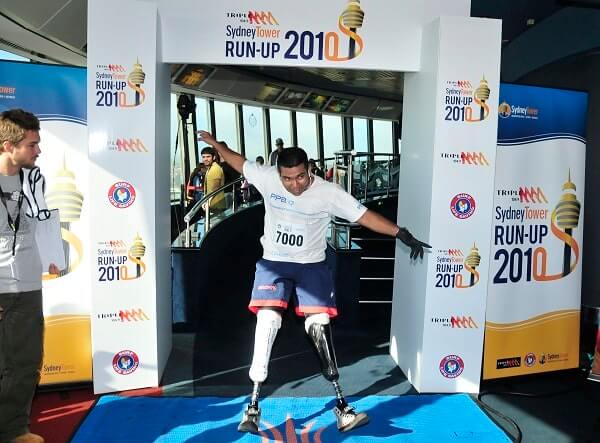
After several steps and self-affirmations, Dwayne became the first double amputee to ever run up the Sydney Tower Eye. He did it in 23 minutes and 12 seconds. Two years later, he returned to improve his time and finished the climb in 20 minutes and 14 seconds.
World records need setting
“You should put the logo on my shirt and send me to New York to run up the Empire State Building,” Dwayne jokingly said to one of the partners of his firm the Friday after his first race.
“Draft up a memo… and we will speak on Monday,” they responded.
On a snowy February day in 2009, Dwayne climbed 86 storeys of the Empire State Building in a record time of 26 minutes and 12 seconds. He is the first and fastest double amputee to do it.
After his stint in NYC, Dwayne soon found himself flying out on weekends to different cities, climbing towers and returning to work on Monday.
“When most people were spending their weekends on PlayStations and talking about games, I was in Singapore or Vietnam, just setting world records for other people to break,” Dwayne said.
Dwayne also holds world records in 100m and 200m races at the Retro Running (also known as backwards running) World Championships (2016) that took place in Essen, Germany.
Though he is pleased that his records still stand, he is prouder to be the first one to set them.
For Dwayne, tower climbing and setting world records were about driving equity and awareness.
“I was one of the few people up running up towers with business cards in my pockets,” Dwayne said.
READ ALSO: Meet the disability advocate petitioning to make dating apps more inclusive
Becoming Dwayne Fernandes
Dwayne Fernandes, 36, was born in Bombay (as he remembers it), but his family moved from India to New Zealand where he completed his schooling before moving to Australia in 1999.
Due to a severe bone defect, Dwayne was born without fibulas, causing him to have problems with balance. Before he was three, he had already undergone five surgeries, and at age 11, he made a courageous choice to replace both his legs with prosthetic limbs.
“We understand how the quality and the value of life is in these different countries, don’t we? There’s a low quality of life if you have a billion-plus people,” Dwayne shared. “When I was born in India as a person with a disability (PwD), my mum knew that we had to leave so that I could have a better life.”
Dwayne’s mother was shocked to find out they had been accepted into New Zealand. She double-checked with visa officers to make sure they knew her son had a disability. She found comfort in their response: “You son is not unable to do everything, it’s just a few things he won’t be able to do.”
Dwayne commends New Zealand’s schooling system, which didn’t segregate between PwD and others, and provided a physical disability unit available for use on every campus. He reveals this inclusive approach did something very important for the kids; “making them realise that society is diverse, and is made up of a variety of different people”.
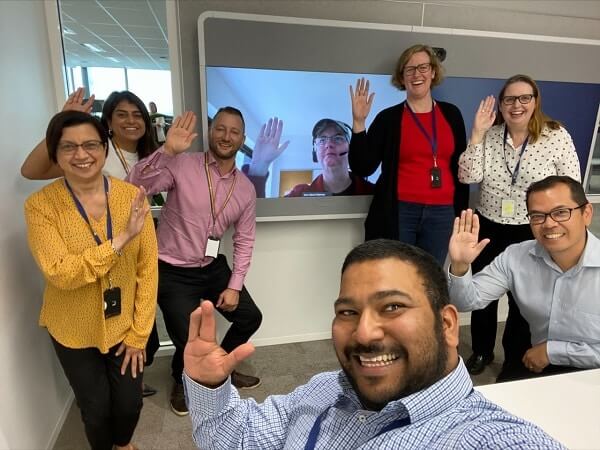
Dwayne witnessed first-hand the different attitudes in these countries and knows what inclusivity feels like.
When he worked with Transport NSW, he noticed that “his people” (PwD), weren’t being promoted.
“After I gave that feedback, I grew the network at the organization from 50 people to over 300. It became the largest disability employment network in the public sector in the year 2020,” he said.
Now he works as a Diversity and Inclusion partner at the NSW Department of Planning, Industry, and Environment, helping to make more and more spaces inclusive.
Dwayne lives in Sydney with his wife Olivia and two daughters, Esme and Enola. He says NDIS (National Disability Insurance Scheme) has helped him improve his physical quality of life so that he can be a good father and husband, and be more useful around the house.
“It’s a lengthy process now because each different disability is a complex step. It is a great system; it just gets a bit politicised sometimes” he said.
Gaming for kids with autism
In addition to his daytime job, Dwayne Fernandes is also the co-founder of Minds At Play. He had already been playing video games as an outlet for stress for a few years, but with the desire to connect with his godchild who has autism, he transformed the hobby into a gaming platform for PwD.
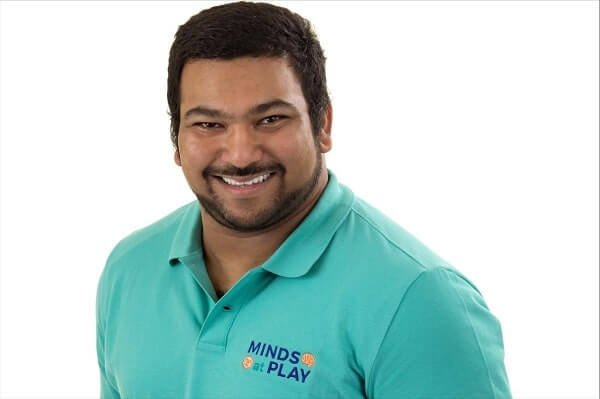
Dwayne and his business partners, Dan Papallo and Jeff Ozog launched Minds At Play in 2019 as a platform where people on the spectrum could play Dungeons and Dragons and Minecraft to help them build social and communication skills.
In their first online session in June 2020, they had no idea starting their side business in the middle of a pandemic would be such a success.
“The support coordinator had never seen such engagement from her class or from her clients before. She’d never seen these boys, socialize and come together and want to hang out and also make contact with each other,” Dwayne shared.
With the help of the Luke Priddis Foundation and digital gaming developer Bouncyrock’s support, Minds At Play currently host 151 players in their online gaming sessions.
What would Dwayne Fernandes say to someone like him who wishes to set world records and change the world?
“If you want to do something that has never been done before, I say, ‘go for it!’ and most of these things can be practiced,” he said.
“By looking to do things that people have never done before, you end up improving the place, improving the technology, and engagement in that way.”
For his next adventure, Dwayne wants to be the first double amputee in space.
So far, there have only been four people with disabilities who have been to space. The most recent astronaut was 30-year-old Hayley Arceneaux on Space X’s Inspiration4 flight.
“There’s plenty of value in having people with disabilities going up there and making it more inclusive for everybody else,” he remarked.
But more importantly, he says: “If you have a goal that big, you end up doing a whole bunch of other smaller things that are pretty impressive.”
READ ALSO: India at the Tokyo Paralympics: all the medal winners so far



